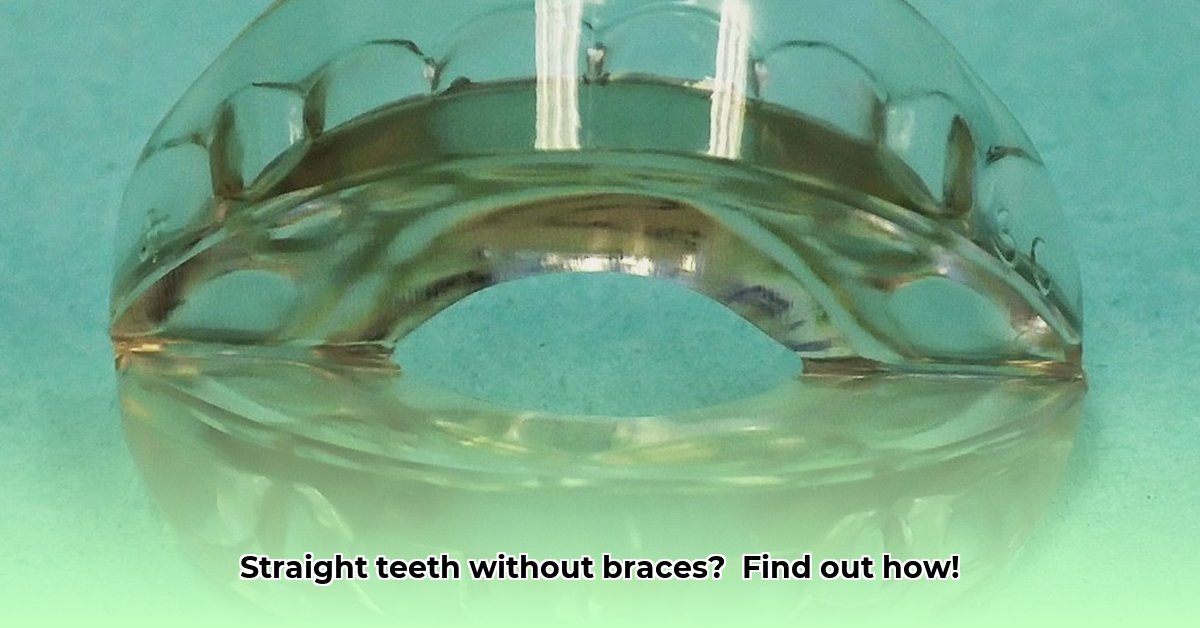Want a straighter smile but not crazy about the idea of traditional braces? There are lots of other ways to get the smile you’ve always wanted! This guide breaks down the different options for straightening your teeth, from invisible aligners to other cool technologies. We’ll compare the pros and cons of each, talk about costs and how long treatment takes, and help you figure out which method is best for you. Whether you’re curious about Invisalign, those braces that go behind your teeth, or something else entirely, we’ve got you covered. We’ll even look at at-home aligner systems and what to expect from those. Let’s find the perfect path to a healthier, happier smile!
Alternatives to Braces: Straightening Your Smile in 2025 – Explore Your Options for a Perfect Smile!
Thinking about a straighter smile but not thrilled about traditional metal braces? You’re in luck! Loads of excellent alternatives are available today, making it easier than ever to get the smile you’ve always wanted. Let’s dive into your options and explore the latest orthodontic advancements.
Clear Aligners: The Invisible Choice for a Discreet Smile Transformation
Clear aligners, like Invisalign, are incredibly popular. They’re custom-made, nearly invisible plastic trays that gently shift your teeth. Want a discreet way to straighten your teeth without anyone noticing? This might be your perfect solution, as they offer almost invisible teeth alignment.
Pros: They’re practically invisible, easy to remove for eating and brushing, and generally very comfortable to wear. You can maintain excellent oral hygiene.
Cons: They aren’t suitable for every type of misalignment, particularly severe rotations or vertical discrepancies. You’ll need to be disciplined about wearing them as directed (typically 20-22 hours a day), and they can be pricier than some other options. Also, some people report some initial discomfort when starting a new set of aligners. The average cost ranges from $3,000 to $8,000, and treatment length is typically 6-18 months. Is the trade-off between discretion and treatment complexity worth it for your specific needs?
Lingual Braces: The Secret Weapon for Hidden Teeth Straightening
Lingual braces are attached to the back of your teeth, making them completely hidden. They’re just as effective as traditional braces, offering the same teeth-straightening power but with ultimate discretion. This means you can get effective teeth correction discreetly!
Pros: They are completely invisible, a big plus for those who want to avoid the look of traditional braces. They’re also effective for even complex cases, offering a strong solution for significant alignment issues.
Cons: They tend to be more expensive than traditional braces, with costs ranging from $8,000 to $13,000, and can feel a little less comfortable at first. It might also take a bit longer to adjust to speaking with them, as they may slightly affect your speech initially. The brackets can irritate the tongue, and treatment can last 18-36 months.
At-Home Aligner Systems: DIY Teeth Straightening for Budget-Conscious Consumers?
Several companies now offer at-home aligner systems as a more budget-friendly approach. You take impressions of your teeth at home (some send a kit, others use smartphone technology), and they send you custom-made aligners in the mail. Keep in mind, however, that professional oversight is paramount for success.
Pros: The convenience is a big draw, and they are typically significantly more affordable, usually ranging from $1,800 to $2,500. It’s a less expensive approach compared to traditional orthodontic treatment. And you don’t have to visit an orthodontist as frequently.
Cons: Because there’s less direct supervision from a dental professional, there’s a slightly higher chance of problems, such as inaccurate impressions leading to poorly fitting aligners. These systems might not be suitable for complex cases, and it’s crucial to discuss any concerns with a dentist or orthodontist before starting. Treatment times average 4-6 months, but can be longer if issues surface. While the upfront cost is lower, potential issues down the line could make the treatment more expensive overall. Byte and NewSmile are popular options.
Veneers: A Quick Cosmetic Touch-Up for a Picture-Perfect Smile
Veneers are thin, custom-made shells that are permanently bonded to the front of your teeth. They’re fantastic for improving the appearance of your teeth – think covering up chips, minor gaps, or discoloration. They are not, however, a solution for major misalignments. This is a perfect way to achieve a flawless smile with cosmetic enhancements.
Pros: Veneers deliver quick, noticeable results and give your teeth a beautiful, even appearance. They can also correct minor imperfections in tooth shape and size. Porcelain veneers are stain-resistant.
Cons: They aren’t designed to fix crooked teeth or bite problems. It’s also important to realize that once veneers are placed, the procedure is irreversible, as some enamel needs to be removed. Veneers can cost $925 to $2,500 per tooth, and they typically last 10-15 years. A consultation with a cosmetic dentist is a must before going this route.
Palatal Expanders: A Growing Solution for Jaw Development
Palatal expanders are used mainly in children and teenagers to widen the upper jaw. They’re frequently used to create more space for adult teeth before other orthodontic work is needed. This is a proactive step towards optimal jaw development in children.
Pros: They effectively correct jaw width issues, making room for teeth to grow into more naturally. Often used early on to prevent bigger issues later. They improve breathing and can help with crossbites.
Cons: They are specifically designed for children and young adults whose jaws are still developing. Most people find them to be a little uncomfortable initially. Speech can be affected temporarily, and the cost ranges from $2,000 to $3,000. Treatment typically lasts 3-6 months, followed by a retention period.
Ceramic Braces: A Less Noticeable Traditional Option
Ceramic braces work like traditional metal braces, but use tooth-colored or clear brackets. This makes them less visible.
Pros: Less noticeable than metal braces. They are a relatively strong and effective straightening method.
Cons: More expensive than metal braces, costing around $4,000 to $8,000. The ceramic brackets can stain, and they may be more prone to breakage than metal. Treatment lasts 18-36 months.
How to Choose the Right Path: It’s Personal – Factors to Consider for Your Smile Journey
The best approach to straightening your teeth depends entirely on your unique situation. Let’s look at some key factors that determine which treatment is best, including aligning your treatment with your specific needs:
-
The Severity of Your Misalignment: For really crooked teeth or complex bite problems, traditional braces or even surgery might be necessary. Clear aligners or at-home systems may not be strong enough to correct serious issues. An orthodontist can assess the Angle classification of your malocclusion to determine the best approach.
-
Your Budget: Treatment costs differ significantly. At-home aligners are generally the most affordable, while lingual braces are usually the most expensive. Clear aligners and traditional braces fall somewhere in between. Payment plans and insurance coverage can help manage costs.
-
Your Lifestyle: Removable aligners (clear and at-home) require commitment. You need to wear them most of the day to see results. Traditional or lingual braces are a more permanent solution that requires less active participation from your side. Consider your daily routines, eating habits, and social activities.
-
Your Aesthetic Preferences: How important is it for your treatment to be hidden? Lingual braces offer maximum discretion, while traditional braces are the least discreet. Clear aligners and ceramic braces fall in the middle.
Crucial Note: Always, always consult a qualified orthodontist or dentist. They can properly assess your situation, recommend the best course of action, and create a personalized treatment plan. Don’t rely solely on online information; professional guidance is essential.
Comparing Options: A Handy Guide for Informed Decisions
| Treatment Option | Estimated Cost | Discreetness | Effectiveness | Best For | Average Treatment Time |
|---|---|---|---|---|---|
| Clear Aligners | $$$ – $$$$ | High | Moderate-High | Mild to moderate crowding, gaps | 6-18 Months |
| Lingual Braces | $$$$ – $$$$$$ | Very High | High | Most cases, especially those wanting invisibility | 18-36 Months |
| At-Home Aligners | $ – $$$ | Moderate | Moderate | Mild misalignment; needs professional check | 4-6 Months |
| Veneers | $$$$ – $$$$$$ | High | Low | Cosmetic improvements only; not for misalignment | Permanent |
| Palatal Expanders | $$ | Low | High (for children) | Jaw expansion in growing children | 3-6 Months |
| Traditional Braces | $$ – $$$$ | Low | High | Most cases, especially severe misalignments | 18-36 Months |
- Plant-based Diet Colitis Remission: Success Stories - December 18, 2025
- Plant Based Diet Breast Cancer: Research-Based Benefits - December 16, 2025
- Plant-Based Diet Ulcerative Colitis Remission: Proven Benefits - December 15, 2025










